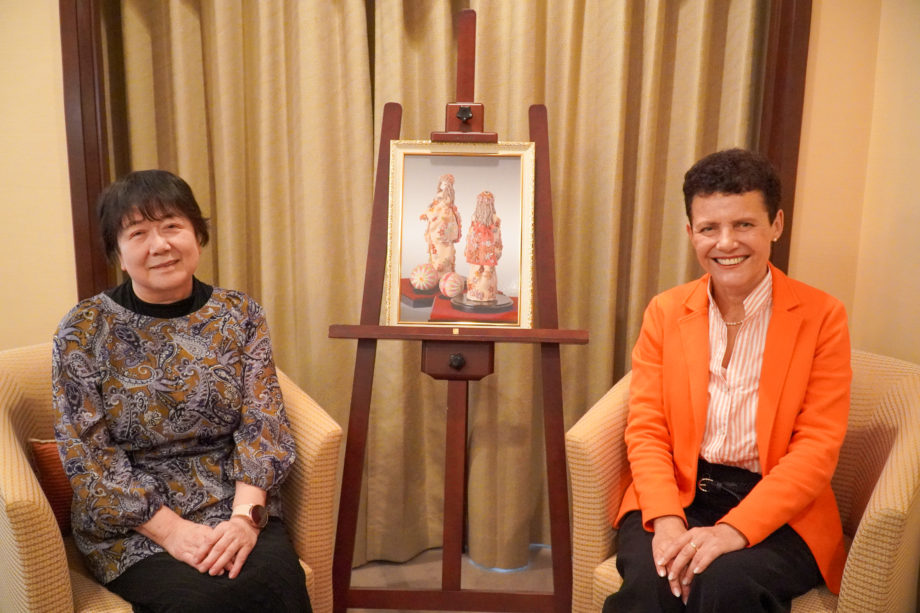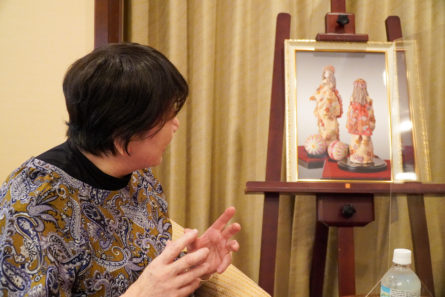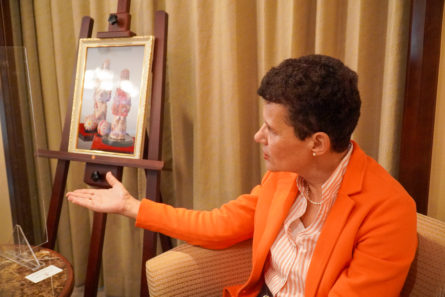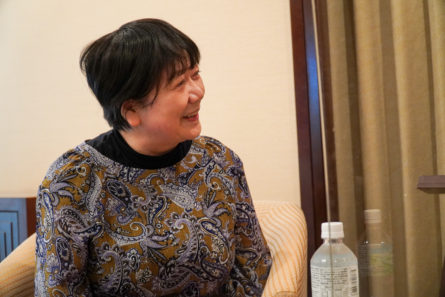- JEPAA Member
- Romance Doll
- Kayoko Furihata
- ロマンドール
- 降旗香代子
© 2024 Kayoko Furihata.
SCROLL
Portfolio /作品一覧
- 逢いたい人 ~ひまわり~/someone I want to meet~Himawari~
- モルダウ/Moldau
- 優しさに包まれて/Surrounded by Kindness
view more
Special Talk /特別対談
洋の東西を越えた人形の世界、秘訣は素直な気持ち

カトリン=スザンネ・シュミット(以下 シュミット):先生は工芸の中でもいろいろなジャンルで作品発表されていらっしゃいますが、今回の池袋展出展作はどのようなものなのでしょうか?
降旗香代子(以下 降旗):これは「わらべ唄」というロマンドールの作品です。型は使わず、一から自分で形成しました。女の子が「何をしよう」と考えている、そんな愛らしい場面を表現したいと思って作った物です。着物のところにお花があるんですがこれはドイツの伝統工芸のクロスターアルバイテンの技術を使って制作しています。
シュミット:なるほど。こちらの作品は人形はヨーロッパ風の顔をしていますが、着物を着ていますね。日本と西洋が混ざったような印象を受けましたが、この人形はなぜヨーロッパ風の顔にされたんでしょうか。
降旗:それはよく言われるんです。「和人形なのにどうしてヨーロッパ風の顔なの?」と。確かに不思議に思われるかもしれませんが、私はこのヨーロッパ風の顔がとても好きなんです。そのため意識しているわけでもないのに作品は自然とヨーロッパ風の顔になるんです。それと、私は日本がモチーフの人形だからと言って顔も日本風にしないといけないといったこだわりはありません。とにかく自由に表現したいです。
シュミット:ご自身の制作したいものを思うように表現されているのですね。日本とヨーロッパが混ざり合ったような感覚があってそれこそ文化交流みたいですね。この着物も陶器ですか?
降旗:はい。釉薬をかけて焼いた陶器のお人形にゴールドやシルバーのワイヤーで作った花をあしらいました。柔らかい感じや優しい雰囲気が表現できればと思って制作しました。
シュミット:確かに。とても優しい雰囲気ですね。先生が作られるのはお人形だけですか。
降旗:それ以外にも作りますよ。「わらべ唄」の人形が持っている手まりも、私が作った物です。
シュミット:この手まりもご自身で作られたんですか?私は松本城に行った時に手毬のお店でこういったものを見たことがあるのですが、すごく精巧な技術ですね。
降旗:私はその隣の安曇野市に住んでいるのでそれはよく存じています。
シュミット:今後チャンスがあれば松本城を案内して頂きたいです。あそこはとても桜が綺麗でした。逆に降旗先生、いままでドイツに来られたことはありますか?ドイツの陶器といえばマイセンが有名ですが、先生も関心はありますか。
降旗:はい、マイセンは大好きです。でもまだ行ったことはないんです。
シュミット:そうでしたか。日本とマイセンは交流が深くて、有田焼で有名な有田とマイセン市は姉妹都市になっています。私は 30 年前、姉妹都市提携を結ぶ式典に参加するために有田市まで行ったことがあります。その際に陶器のことを勉強したので、ドイツと日本の陶器についてはよく存じ上げているつもりです。
降旗:そうなんですね。マイセンはいつか行ってみたいです。私にとっては憧れの場所なので。
シュミット:是非作品と一緒に来てもらいたいです。マイセンには大きな陶器美術館や製作所もあるので精巧な作品を目にする絶好の機会になるかと思います。先生の作品も精巧に作られていますよね。着物の軽やかな質感はどのように表現されているんですか。
降旗:とくに技術として何か用いているわけではないのですが、陶器の硬い印象が出ないよう気をつけています。
シュミット:なるほど、心なんですね。降旗先生のお話を伺っていると、作品を制作するで心をとくに大切にする意識が伝わってきます。
降旗:私は制作する時「可愛い」「美しい」だけではない心が表れるお人形を作るように心がけています。生きていれば悲しみ、苦しみといった辛いことがあるじゃないですか。でもそれを受け止めた先に本当の優しさを知ることができる気がするんです。いつも前を向いて、内面に強さを持ち、辛いことも嬉しいことも呑み込んだ上で全ての気持ちを包み込んでいられますようにという願いを込めて制作しています。
そしてこれからもその時々の気持ちを人形に込めて制作していきたいと思っています。人に合わせるとかではなく、自分の気持ちに素直なものを作っていきたいです。
シュミット:制作をする方の気持ちは何よりも大切ですね。これからも気持ちのこもった作品を楽しみにしております。次会うときは松本城でお会いしましょう。本日はありがとうございました。
降旗:ありがとうございました。
(2022年特別対談 降旗香代子×カトリン=スザンネ・シュミット)
The world of dolls transcending all countries—the secret is honest feelings
Katrin-Susanne Schmidt: You have presented works in various genres even within the realm of arts and crafts. So what kind of work will you exhibit on this occasion at the Ikebukuro exhibition?
Kayoko Furihata: This is a Roman doll work called“Warabe uta (Children’s song).”I didn’t use a mold, but shaped it myself from nothing. The girl is thinking,“What shall I do?”—I made it with the desire to express a pretty scene like that. The flowers on the kimono I made using techniques from the traditional German craft of Kloster-Albayten.
Schmidt: Interesting. In this work, the doll has a European-style face yet is wearing a kimono. I get the impression of a mix of Japan and the West here—why did you decide to give the doll a European-style face?
Furihata: I often have that said to me. I get asked“Although it’s a Japanese doll, why does it have a European-style face?”I admit it might seem strange here; however, I very much like European-style faces. So, although I wasn’t conscious of it, the work naturally found itself with a European-style face. Also, I don’t have any particular feel that I must give it a Japanese-style face because it is a doll with Japan as motif. I just want to be free to express.
Schmidt: You express your work as you yourself wish it, I think. The sense of a mixture of Japan and Europe itself is like a cultural exchange, isn’t it? Is this kimono ceramic too?
Furihata: Yes. I glazed and kilned the ceramic doll, and then dressed it up with flowers made from gold and silver wire. I produced it hoping I could express a soft sense and gentle atmosphere.
Schmidt: Undoubtedly so. There is a very gentle atmosphere about it, isn’t there? Do you create works other than dolls?
Furihata: I do make other things. I also made the handball that the“Warabe uta”doll is holding.
Schmidt: You made this handball yourself? I have seen them like this in a handball shop when I went to Matsumoto Castle—this is such intricate work.
Furihata: I live in the neighboring city of Azumino, so I know it well.
Schmidt: I ’d like you to show me around Matsumoto Castle if there is ever the chance. The cherry blossom there was very beautiful. Ms. Furihata, have you ever been to Germany? Meissen is famous among German ceramics— are you interested in it at all?
Furihata: Yes, I like Meissen very much. But I’ve not been there yet.
Schmidt: Is that so? The exchange between Japan and Meissen runs deep, and Arita— famous for Arita ware—and Meissen are sister cities. 30 years ago I went to Arita city to participate in the ceremony for forming the sister city partnership. I studied about ceramics for that, and I know a bit about German and Japanese ceramics.
Furihata: I see. I’d like to go to Meissen one day. It’s somewhere that I dream of.
Schmidt: I’d really like you to come and bring your work. Meissen has a large ceramic museum and factory, and I think it would be a great opportunity to see intricate works of art. Your works are produced so intricately, too. How did you manage to express the light quality of the kimono?
Furihata: I didn ’t use any technique in particular, but was just careful not to let the ceramic give a hard impression.
Schmidt: It’s about the heart, isn’t it? Listening to what you say conveys a consciousness of how particularly important the heart is when producing artwork.
Furihata: When I work, I endeavor to create dolls that are not merely“pretty”or“beautiful,” but which express my heart. Doesn’t living sometimes mean hard times like sadness and suffering? However, I feel that those afflicted by it can know real gentleness. I make dolls wishing that they may engulf both hard and happy times and embody all feelings in order to always look ahead and have strength inside. I’m hoping to continue to fill my dolls with my feelings at the time I make them. I want to make things that are honest to my own feelings, not to suit anybody else.
Schmidt: The feelings of the maker is important more than anything, isn’t it? I’m looking forward to further artworks full of feelings. Let’s meet next at Matsumoto Castle. Thank you very much.
Furihata: Thank you very much.
(Special Talk Session in 2022:Kayoko Furihata×Katrin-Susanne Schmidt)
Profile /経歴
降旗香代子 Kayoko Furihata
1949年生まれ 長野県安曇野市在住
ロマンドール師範
オルネフラワー協会公認校、ペーパーデコレーション協会、JKA日本クロスターアルバイテン協会認定校
Born in 1949. Lives in Azumino City, Nagano, Japan.
Master of Romance Doll
affiliated with Authorized school of Orne Flower Association, Paper Decoration Association, JKA Japan Kloster Albaiten Association

-430x608.jpg)






